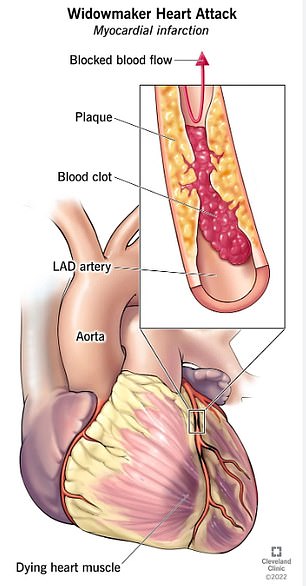I’ve died EIGHT times due to frightening ‘widow-maker’ heart attacks
A man died eight times after suffering fatal ‘widowmaker’ heart attacks, which usually kill nine in 10 victims.
Evan Wasserstrom, who lives in Los Angeles, was 40 when he was rushed to the hospital with a complete blockage in his left main coronary artery (LMCA), causing his heart muscle to begin to die.
LMCA is responsible for supplying blood to the left side of the heart muscle with blockages that cause the so-called ‘widow-maker’ heart attack – which was nicknamed because it is much deadlier than other heart attacks.
His heart stopped beating six times in the ambulance on the way to hospital and twice more when he got there before he was put into an induced coma to protect the brain and reduce pressure on his heart.
Doctors feared he would never wake up or, if he did, wouldn’t be able to walk or talk. But when they disconnected the life-support machine, Mr. Wasserstrom, now 48, said he “miraculously came back to life.”
Evan Wasserstrom, now 48, living in Los Angeles, was rushed to the hospital with a “widowmaker” heart attack. He died six times in the ambulance, when his heart stopped, and two more times in the hospital

The above image shows what happens in a widow’s heart attack, caused by a blockage of the left main coronary artery (LMCA)
Heart attacks affect about 800,000 Americans each year, mostly adults over age 65. More than 90 percent of patients survive.
Widow heart attacks are a rare form of heart attack that does not normally occur in men under the age of 45.
The American Heart Association says only 12 percent of those who experience the attack outside of the hospital survive. Those admitted had a 25 percent chance of survival.
Other survivors of the attack, including Rosie O’Donnell, have previously said they consider themselves “really lucky” to be alive.
During the attack, the LMCA is partially or completely blocked, cutting off blood flow to the muscle at the front of the heart.
This deprives the muscle of oxygen and can cause it to stop beating completely, which also cuts off the oxygen supply to the rest of the body. This is different from a heart attack, where the heart continues to beat, but the affected part may not get enough oxygen, which can lead to damage – which can be fatal.
Mr. Wasserstrom, who works as a writer and is originally from New Jersey, revealed in an essay in the initiate that his heart attack was caused by a complete blockage in his LMCA and a 70 percent blockage in a second artery.
He was preparing to take his Labrador, Atticus Finch, for a walk when he suddenly felt a “burning” sensation in his left arm.
“It was like the sun was burning in the veins of my left arm,” he said.
‘(I was) sweating profusely, I felt like I had just gone swimming with all my clothes on.
‘It was a feeling I had never experienced before.’
He called 911 and two firefighters arrived at his door moments before he collapsed and his world went black.
Mr. Wasserstrom was rushed to the hospital, where doctors restarted his heart over and over again using defibrillators, which deliver electric shocks to the heart muscle.
At the hospital, doctors performed stent surgery – removing the blockage in the artery and then inserting a mesh tube to keep it open – to restore blood flow to his entire heart muscle.
He was then put into a coma and put on a life support machine for five days to help his heart recover and keep beating.
“The doctors didn’t believe I would survive, and even if I did, they didn’t think I would be able to walk or talk,” he said.
“But (when they unplugged it), instead of hearing one last flat line on the heart monitor — or getting a heartbeat but seeing no other activity — I miraculously came to life and tried to get out of my ICU -bed to escape.’

Mr. Wasserstrom is pictured above in the hospital. His heart stopped beating six times en route and two more times in the ward before he was put into an induced coma
Doctors were concerned that Mr Wasserstrom could suffer complications from the heart attack because other parts of his body had been deprived of oxygen for periods.
The brain is particularly vulnerable to this, because cells in the organ begin to die if they are deprived of oxygen for just one minute.
Mr. Wasserstrom did not reveal what doctors believe might have caused the heart attack.
But in previous cases, blockages in the artery have been linked to high cholesterol, high blood pressure, smoking, diabetes, stress and inactivity.
These all increase the level of inflammation in the body, increasing the risk of damage to the lining of the arteries, causing plaques to appear that can become loose and block the artery.
Genetics can also increase risk, with people with a family history of the disease at greater risk.
